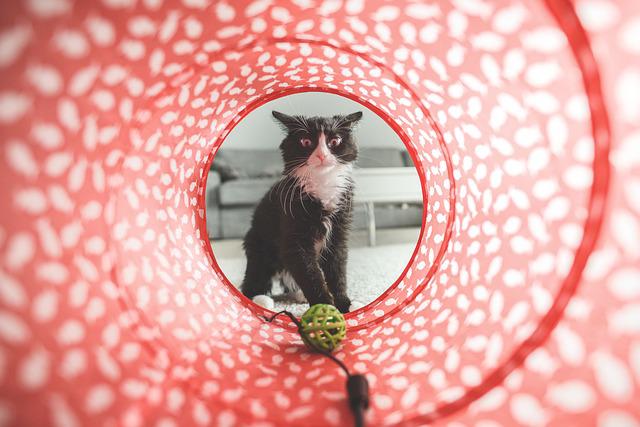Can a Cat Be Trained: Tips When Training a Cat and Tricks to Tell Them
Yes, cats can be trained! While many people think of dogs as being more trainable, cats are quite intelligent and can learn a variety of behaviors and tricks. However, it’s important to remember that cats are not motivated by the same things as dogs and may require different training techniques. Some common behaviors that cats can be trained to do include using a scratching post instead of furniture and coming when called.


Table of Contents
Cat Training Tips
Start Early
Starting early is key when it comes to training a cat. Kittens are more adaptable and open to learning new things than adult cats, so it’s best to start training as early as possible. However, older cats can still learn new behaviors with patience and consistency.
It’s important to remember that cats are not like dogs and cannot be trained similarly. So rather than changing a cat’s natural behaviors, working with their instincts and tendencies to encourage positive behaviors is better.
Some basic training techniques for cats include using positive reinforcement, such as treats or toys, to reward good behavior. This can be particularly effective when training cats to use a litter box or scratching post.
Use Positive Reinforcement
Positive reinforcement is an effective and humane method to train cats. Positive reinforcement involves rewarding your cat for good behavior rather than punishing them for bad behavior. This could include giving them treats, praise, or playtime when they perform desired behaviors, such as using a scratching post or litter box.
Positive reinforcement can teach your cat new behaviors, such as coming when called or sitting on command, and modify unwanted behaviors.
Eliminate Distraction
Eliminating distractions is an important aspect of cat training, according to WebMD. Cats are naturally curious and easily distracted by their environment, so creating a calm and quiet environment for training is important. This can be done by selecting a quiet room or area of your home, closing doors and windows, and turning off noisy distractions such as the television or radio.
This will help your cat focus on you and the task. Additionally, it’s important to minimize any other stimuli competing for your cat’s attention, such as other pets or people.
Be Consistent
Consistency is key when it comes to training your cat. Always use the same cues and rewards, and avoid confusing your cat by changing the rules. For example, if you’re trying to train your cat not to scratch the furniture, make sure you’re consistent with redirecting them to a scratching post and rewarding them when they use it instead of the furniture.
If you’re consistent and sometimes let them scratch the furniture or don’t reward them when they use the scratching post, they may need clarification, and the training process may take longer.
Keep Training Sessions Short
It is recommended to keep training sessions short, especially for cats, who may have shorter attention spans than dogs. For example, a training session of 5-10 minutes a day can be enough for a cat. It’s better to have multiple short sessions throughout the day rather than one long session. Additionally, it’s important to end training sessions positively, with a reward or praise, to keep the cat motivated for the next session.


Use Clicker Training
Clicker training can be a useful tool in cat training. Clicker training is a form of positive reinforcement training that uses a clicking sound to mark the desired behavior and a reward, such as a treat or praise, to reinforce the behavior.
To use clicker training with your cat:
- Choose a clicker that makes a distinct, consistent sound.
- Click the clicker and immediately offer your cat a treat or praise.
- Repeat this several times so your cat associates the clicker’s sound with a positive outcome.
Next, choose a behavior you want to train your cat to do, such as sitting or coming when called. Then, when your cat performs the desired behavior, immediately click the clicker and offer a reward. Then, with repetition, your cat should associate the behavior with the click and the reward and will be more likely to perform the behavior in the future.
Remember to keep training sessions short and only train one behavior at a time. Clicker training can be a fun and effective way to train your cat, but it does require patience and consistency.
Be Patient
Being patient is an important cat training tip. Cats are independent animals and may take longer to learn certain behaviors or tricks than dogs. So it’s important to remember that training should be a positive experience for you and your cat, so avoid getting frustrated or angry if your cat doesn’t seem to be getting it right away.
Instead, try breaking the behavior or trick it into smaller, more manageable steps and reward your cat for each small success. With time and patience, your cat can learn some impressive skills!
Consider Professional Training
While most cats can be trained at home with consistency, patience, and positive reinforcement, some may benefit from professional training. For example, if you are struggling with training your cat or if your cat is exhibiting problematic behaviors, consider seeking the help of a professional cat trainer or behaviorist.


They can provide customized training plans and techniques tailored to your cat’s needs and temperament. They can also identify underlying issues contributing to your cat’s behavior and provide you with strategies to address those issues.
Tricks to Teach Your Cats
- Sit: Teach your cat to sit on command by holding a treat above its head and moving it back towards its tail. Following the treat with their head, their rear end will naturally lower to the ground. Say “sit” as soon as their bottom touches the ground and reward them with the treat.
- Shake: Hold a treat in front of your cat’s paw and gently tap its paw until they lift it. Say “shake” and give them the treat. Repeat until your cat lifts their paw when you say “shake.”
- High Five: Once your cat has mastered shaking hands, move your hand slightly higher and say “high five.” Reward them with a treat when they touch your hand with their paw.
- Come: Encourage your cat to come to you by calling their name and rewarding them with treats when they come to you. Start with short distances and gradually increase the distance over time.
- Roll Over: Start by getting your cat to lie down on their side. Hold a treat above their head and move it back towards their tail, encouraging them to roll onto their back. Say “roll over” and give them the treat when they complete the action.
- Jump: Hold a treat above your cat’s head and move it slightly out of reach. Say “jump” and reward them with the treat when they reach it.
